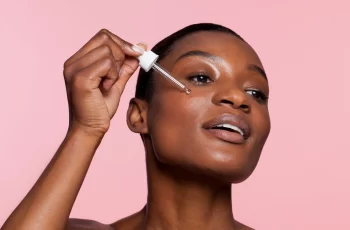
Peppermint Oil in Skin Care
Peppermint oil, specifically from the Mentha piperita species, is an effective antioxidant, anti-inflammatory, and antimicrobial ingredient used in many types of skin care products.
It has a storied history of use in the food, cosmetic, pharmaceutical, and hygiene industries.
The primary component of peppermint oil, menthol, has been found to confer many of the benefits associated with peppermint oil. (6,7)
There is a very low risk of allergy and it remains just as popular today as it has ever been in skin care, with demand growing every year for the ingredient. (25)
Keep reading to learn about the science of peppermint oil in skin care, and take the Baumann Skin Type Quiz to make sure this ingredient is right for your skin!
What are the effects of peppermint oil on skin?
Peppermint oil helps keep the skin clean from bacteria, binds free radicals, and treats various kinds of hyperpigmentation by inhibiting melanin production.
It causes a cooling sensation on the skin due to the menthol it contains.
New research is underway constantly on the effectiveness of peppermint oil, but dozens of studies currently exist to support its beneficial uses in skin care. (1-37)
The most significant benefits peppermint oil has on the skin are typically considered its anti-inflammatory, analgesic, antiseptic, and cooling properties.
Peppermint oil does not hydrate the skin, so it is not considered a moisturizing ingredient.
What is Peppermint oil?
Peppermint oil is a common example of an essential oil; it is thin, fragrant, and composed primarily of antioxidant, anti-inflammatory plant compounds.
There is a small amount of linoleic acid present in peppermint oil (36), so it does contain lipids.
Since linoleic acid is an unsaturated fatty acid, it could be argued that peppermint oil is a dry oil, but most people consider it an essential oil because the fatty acid content is so low.
What is peppermint oil made of?
What are the active compounds?
The active compounds present in peppermint oil can be broken down into a few categories; phenolic compounds, fatty acids/alcohols, and other plant chemicals like terpenes, and flavonoids.
Peppermint oil is primarily composed of the terpene menthol and its derivatives like menthone, menthyl acetate, and isomenthone among others. (2-4)
Menthol is a well known anti-inflammatory compound, and also expresses much of the oil’s antioxidant capability. (8,9)
Menthol binds the TRPM8 receptor in skin causing a sensation of cooling. It does not actually lower the skin’s temperature.
The most prominent phenols in peppermint oil are rosmarinic acid, caffeic acid, eriocitrin, luteolin, rutin, and hesperidin.
These phenols, notably caffeic acid, are known antioxidant and anti-inflammatory compounds.
There is a small concentration of fatty acids like palmitic, linoleic, and linolenic acids present in peppermint oil, but not enough to moisturize the skin or make the oil occlusive.
Vitamin E (A-tocopherol), a long studied and used antioxidant, is also a present compound in this ingredient.
Dangers of peppermint oil
There are a number of considerations to make before you decide on a peppermint oil product, as this ingredient is not right for everybody.
Some studies suggest that peppermint oil above certain dosages might be toxic.(38)
If you are pregnant, it is advised to avoid large quantities of peppermint oil, and to not use it every day in skin care.
When developing a skin care regimen for pregnancy, it is important to try and use products with clean ingredients.
It is also has a relatively high pH of 8, meaning it might not be great for your skin if you are sensitive to alkaline products.
An allergy to peppermint oil is possible.
If you have extremely dry skin conditions like eczema, there is a chance that peppermint oil can cause some damage to your skin barrier.
Some studies have found that peppermint oil can make the skin slightly more sensitive to airborne allergens and cause redness. (21)
is peppermint oil safe?
Is it safe?
If you are not pregnant, do not have extremely dry or sensitive skin, or an allergy to peppermint, it is safe for use in skin care. (24)
Many studies have been conducted on peppermint oil’s safety, and no significant health threats have been documented in medical publications such as CIR reports.
If you have acne, hyperpigmentation, or wrinkles, peppermint oil may be a safe choice for your skin.
Benefits
The most notable benefits attributed to peppermint oil in skin care are: (1)
Antioxidant
Analgesic
Anesthetic
Anticarcinogenic
Anti-inflammatory
Antimicrobial
Antipruritic
Antiseptic
Cooling
Radioprotective
Uses of peppermint oil
Uses of peppermint oil
Peppermint oil is useful in skin care products that treat various kinds of inflammation, bacterial concerns, or aging/wrinkle-prone skin.
It can be found in various moisturizers, serums, balms, and sunscreens for it hydrating and antioxidant capabilities.
To find out if peppermint oil is right for your custom skin care regimen, take our quiz and shop by your Baumann Skin Type!
Take the Quiz
For acne
Peppermint oil is an effective antimicrobial ingredient which can be useful in many acne routines.
Studies have shown that peppermint oil in combination with certain antibiotics can eliminate a number of harmful facial microbes like Staphylococcus aureus, E. Coli, and others. (20)
The main antimicrobial compound in peppermint oil is menthol.
It is also safe for use in acne because it is not comedogenic, meaning it does not clog the pores of sensitive skin.
The only concern of using peppermint oil on sensitive, acne prone skin is it can cause mild short term irritation or stinging.
For dry skin
Peppermint oil does not contain a significant concentration of moisturizing compounds, meaning it is not generally recommended for extremely dry skin types. It can, however, be found in products for dry skin alongside more potent moisturizing ingredients.
Dry skin types benefit from ingredients with high concentrations of hydrating, soothing fatty acids like linoleic, palmitic, and stearic acids.
In low concentrations, it’s anti-inflammatory benefits outweigh the risk of mild irritation on dry skin.
Here are some of my favorite products with peppermint oil for dry skin:
₫
₫
See Product
For inflammation
Peppermint oil and its derivative menthol have been used to treat inflammation for centuries if not thousands of years across the globe. (2,6,10,11,12)
Studies have found that peppermint oil soothes inflammation by stimulating specific thermoreceptors on the skin which results in the cooling sensation menthol is known for. (12,15,16)
Because it has been studied for so long as an anti-inflammatory, it is one of the most common natural ingredients in over the counter (OTC) topical pain creams.
₫
₫
See Product
For itchy skin
Peppermint oil contains many anti-inflammatory properties which can be useful in the treatment of skin conditions like pruritus. (8)
Pruritus is a dry, itchy skin condition common in seniors. It often occurs on the upper back just out of reach. Menthol cools the skin and helps mask itching, so is often found in anti-itch products.
For wrinkles and sun damage
Menthol, the primary component of peppermint oil, is an antioxidant ingredient which is used in anti-aging products or to treat sun damage.
In a study comparing the antioxidant capability of around a dozen different common essential oils like lavender, peppermint oil demonstrated the most potency. (28)
Multiple studies promote its efficacy as an antioxidant, which means it can be helpful in capturing free radicals caused by UV exposure.
Peppermint oil is regarded for its radiation absorption properties as well, it is decent at absorbing UV-B radiation.
For dark spots
Peppermint oil has been shown to have tyrosinase inhibiting properties, meaning it can be used to treat many kinds of hyperpigmentation.(36)
The best dark spot treatments combine weak tyrosinase inhibitors like peppermint oil with more potent skin lightening ingredients like arbutin, cysteamine, ferulic acid, or niacinamide.
Peppermint oil does not work well on dark spots when used alone.
Concerns like melasma, post inflammatory hyperpigmentation, and freckles all need combinations of various types of skin lightening ingredients in their treatment plans.
Which products contain peppermint oil?
There are many great products that contain peppermint oil on the market, but it can be hard to figure out which are the best, and more importantly, which are the best for you. Before you buy, be sure to take our quiz so you can shop by your own Baumann Skin Type. When you do that, your skin type’s octagon will appear above products if they are recommended for your skin type!


